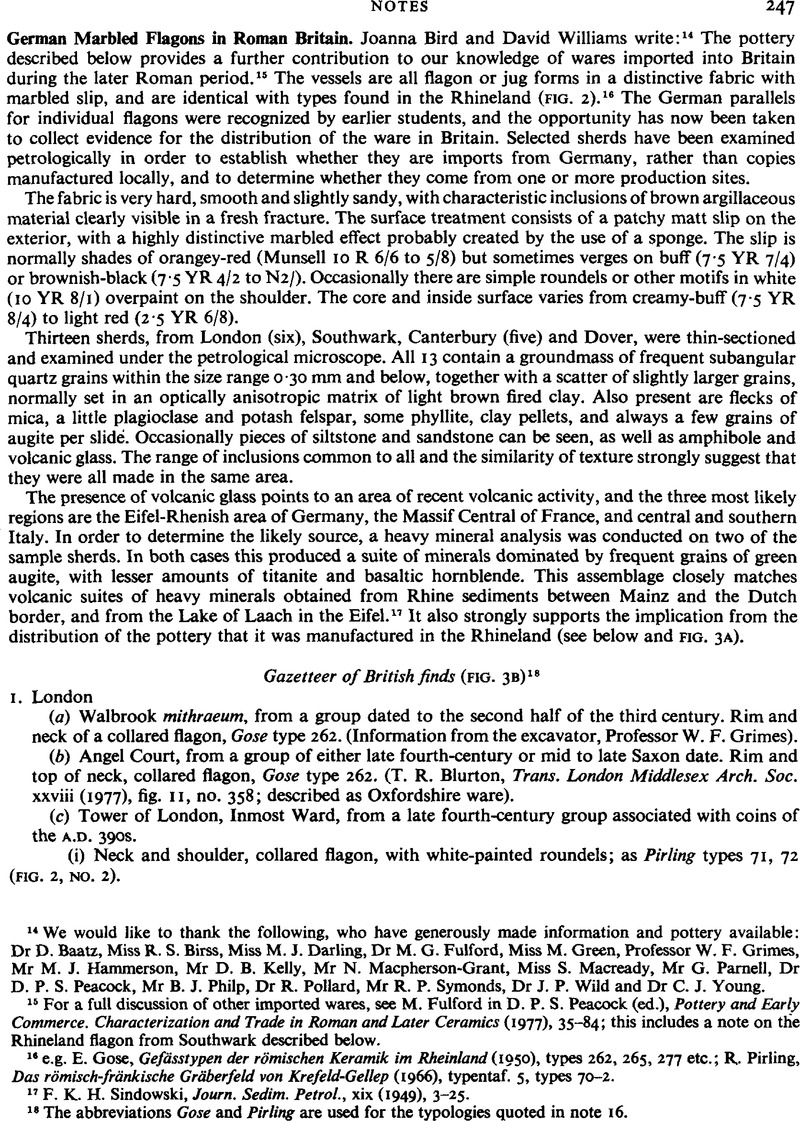Article contents
German Marbled Flagons in Roman Britain
Published online by Cambridge University Press: 09 November 2011
Abstract

- Type
- Notes
- Information
- Copyright
- Copyright © Joanna Bird and David Williams 1983. Exclusive Licence to Publish: The Society for the Promotion of Roman Studies
References
14 We would like to thank the following, who have generously made information and pottery available: Dr D. Baatz, Miss R. S. Birss, Miss M. J. Darling, Dr M. G. Fulford, Miss M. Green, Professor W. F. Grimes, Mr M. J. Hammerson, Mr D. B. Kelly, Mr N. Macpherson-Grant, Miss S. Macready, Mr G. Parnell, Dr D. P. S. Peacock, Mr B. J. Philp, Dr R. Pollard, Mr R. P. Symonds, Dr J. P. Wild and Dr C. J. Young.
15 For a full discussion of other imported wares, see M. Fulford in D. P. S. Peacock (ed.), Pottery and Early Commerce. Characterization and Trade in Roman and Later Ceramics (1977), 35–84; this includes a note on the Rhineland flagon from Southwark described below.
16 e.g. E. Gose, Gefässtypen der römischen Keramik im Rheinland (1950), types 262, 265, 277 etc.; R. Pirling, Das römisch-frähkische Gräberfeld von Krefeld-Gellep (1966), typentaf. 5, types 70–2.
17 Sindowski, F. K. H., Journ. Sedim. Petrol., xix (1949), 3–25.Google Scholar
18 The abbreviations Gose and Pirling are used for the typologies quoted in note 16.
19 F. Oelmann, Die Keramik des Kastells Niederbieber (1914), 45–53.
20 L. Hussong and H. Cüppers, Die Trierer Kaiserthermen. Die spätrömische und frühmittelalterliche Keramik (1972), 17–18.
21 The distribution and probable area of production are discussed by Oelmann, op. cit. (note 19,) 50.
22 Hussong and Cüppers, loc. cit. (note 20).
23 E. M. Wightman, Roman Trier and the Treveri (1971), 201–3.
24 For a description of the various white-painted motifs, see Pirling, op. cit. (note 16), 49–50.
25 Hussong and Cüppers, op. cit. (note 20), 18, type 40.
26 There are 29 examples from the Krefeld-Gellep cemetery (Pirling, op. cit. (note 16), 74–5), a complete example with a band of white-painted scrolls from a fourth-century grave at Neuss (G. Müller, Die römischen Gräberfelder von Novaesium (1977), taf. 11, no. 5), and sherds of some twenty from the construction levels of the Trier Kaiserthermen, c. A.D. 300–320 (Hussong and Cüppers, op. cit. (note 20), 18).
27 The starting date depends largely on the Niederbieber material, which is dated c. A.D. 190–260 (Oelmann, loc. cit. (note 19)). However, some doubt has recently been cast on this dating: A. King, in A. King and M. Henig (eds.), The Roman West in the Third Century (1981), 55–78.
28 The pit (143) at Richborough which contained a marbled flagon held pottery of very mixed dates, making a date for its filling difficult to estimate. Dr C. J. Young has suggested that its depth and other features indicate a well rather than a pit.
29 Gose, op. cit. (note 16), 23; Pirling, op. cit. (note 16), 72.
30 Pirling, op. cit. (note 16), 74.
31 Hussong and Cüppers, op. cit. (note 20), 18–19, type 41.
32 Fulford, op. cit. (note 15), fig. 2.
33 Fulford, M. and Bird, J., Britannia, vi (1975), 171–81.CrossRefGoogle Scholar
34 There is considerable evidence for harbour and waterfront installations at Dover: this has recently been summarized by B. Philp, The Excavation of the Roman Forts of the Classis Britannica at Dover 1970–77 (1981), 7–9 and fig. 2.
35 Fulford, op. cit. (note 15), 45–7.
36 Williams, D. F., in Galliou, P., Fulford, M. and Clément, M., ‘La diffusion de la céramique ‘á l'éponge’ dans le nord-ouest de l'Empire Romain’, Gallia, xxxviii (1980), 277–8.Google Scholar
37 Fulford, op. cit. (note 15), fig. 4.
- 2
- Cited by




